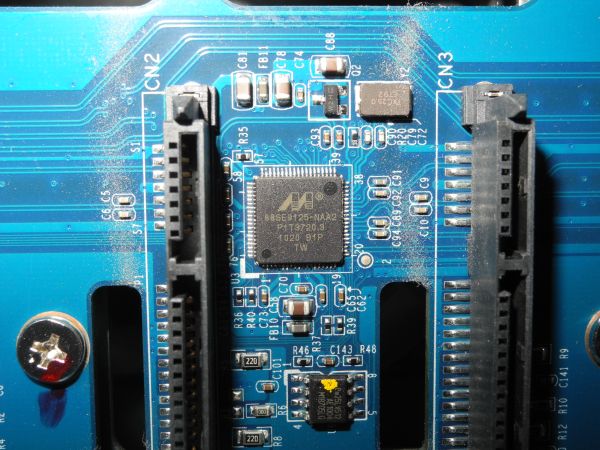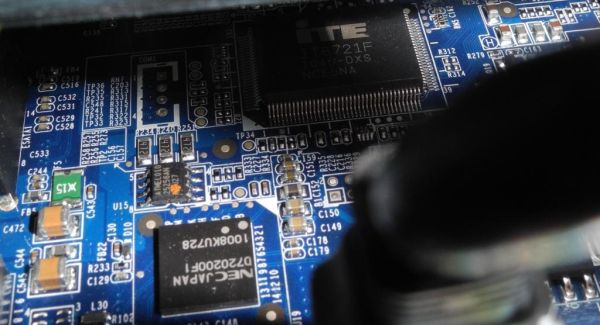QNAP TS-659 Pro II Review
by Ganesh T S on September 19, 2011 8:00 AM EST- Posted in
- IT Computing
- NAS
- QNAP
The host silicon in the SMB / SOHO NAS market is primarily from two players. While the low end is dominated by Marvell, the high end is dominated by Intel's Atom processors. As one goes higher, we have even more powerful Intel CPUs (such as the low end Core i3s). Freescale used to have some design wins till 2009 with their PPC based processors, but we haven't seen any units based on their processors in their last two years.
Removing the drive bays of the TS-659 Pro II reveals an array of 6 SATA slots and a couple of Marvell 88SE9125 chips [PDF]. These are SATA to PCI-E bridges, with support for 2 SATA devices. We believe another of these bridge chips must be present on the other side of the SATA slots array. This array connects to the PCI-E bus on the ICH9 southbridge.
Most of the high end SMB / SOHO NAS units have 1 GB of RAM which can be expanded. The TS-659 Pro II also has 1 GB of RAM expandable to 3 GB. In order to install this notebook memory, one needs to open up the unit. The brushed steel top can be removed by taking off the screws at the rear end and sliding the top out. The motherboard is covered by a screwed on plastic film with a flap above the SODIMM slot where the user can put in the additional memory.
The rest of the components are not easily accessible, but we did manage to grab a snap of the Renesas-NEC 720200 USB 3.0 to PCI-E bridge which enables the two USB 3.0 ports on the unit. The iTE IT8721F is the hardware monitor sensor and fan control chip.
In the next section, we will have the testing methodology outlined and also a description of the testbed.













69 Comments
View All Comments
Toadster - Monday, September 19, 2011 - link
the specs on page #1 show 43W max power, but in the SMB, ISCSI and NFS page - you show 72.3W usage - which is it?also - why the heck are they using a 350W PSU when only 72.3W max? I could see maybe a 100W PSU which may remove the need for the PSU fan (thereby reducing noise?)
overall, very tempted to get this device!
ganeshts - Monday, September 19, 2011 - link
That spec on page #1 is QNAP's claims (and that is with 500 GB hard drives -- mentioned somewhere else). We measured 72.3W and stand by it :)Echo your sentiments on the PSU.. And QNAP claims 350 W PSU when the internal PSU is just 250W (not that it matters when the max power consumption is around 70 W only)
MichaelD - Monday, September 19, 2011 - link
It's sad that a state-of-the-art, $1K+, SMB NAS device still is unreliable when it comes to rebuilds. I stopped using my D-Link DNS-343 (not in the same class as the QNAP) because of all the issues I had with it. Dog slow access speeds, lockups, you name. FW flashes fixed nothing.Granted, the web interface is very attractive and it has a lot of high-end features (and the display is nice looking) but when it comes down to brass tacks, data integrity and availability are all that matters. If I can't rely on this device to successfully rebuild after a drive failure, what good is it?
I built my own NAS (server) out of a mATX mobo/RAM/CPU/HW RAID card I had laying around. I own a copy of Server 2003. I also owned the 5-drive SATA enclosure. Been up for almost 18 months now with a reboot roughly monthly for Windows updates. Zero issues.
These "shoebox NASs" just aren't ready for prime time. STILL.
saiga6360 - Monday, September 19, 2011 - link
Windows updates? LOLjimr1234567890 - Monday, September 19, 2011 - link
What are the effects of going from 1 GB to 3 GB memory? Any better performance? Faster rebuild time? Is there any benefit and if so what are they?BTW: like the article I like the fact you took out a drive and made the system rebuild a disk. Most articles I have read just gloss over any real world test and just regurgitate the products propaganda.
I wonder how well this would work as source of video files from my DNLA complainant TV?
ganeshts - Monday, September 19, 2011 - link
uPnP media server works fine as a source for your DLNA TV.. But, this one doesn't do transcoding.. so hopefully your TV's DLNA profile is good enough for your videos.jimr1234567890 - Monday, September 19, 2011 - link
What would be a good one that can effectively handle transcoding then?ganeshts - Monday, September 19, 2011 - link
I am evaluating something in the ReadyNAS lineup which has Orb inbuilt. This is supposed to have a transcoding engine, but I am yet to test its effectiveness.saiga6360 - Monday, September 19, 2011 - link
Why transcode at all? Get a proper media player. TV media players are crap.DanNeely - Monday, September 19, 2011 - link
Even if the box on your TV has enough computational power to play arbitrary modern formats without special purpose hardware low power handheld devices (phones, and tablets) are unlikely to be able to do so any time soon. Over longer terms unless we eventually reach a point where throwing more hardware at the problem stops yielding better quality images for a given file size I don't expect this to change.Also the number of playback points you have is also a factor. If you only need to stream to one or two TVs spending an extra hundred bucks per screen for more powerful decode isn't a big deal; if your McMansion has a tv in each of a dozen+ rooms then consolidating all of your transcoding into a single location and using dumb hardware at each TV will save significant amounts of money.